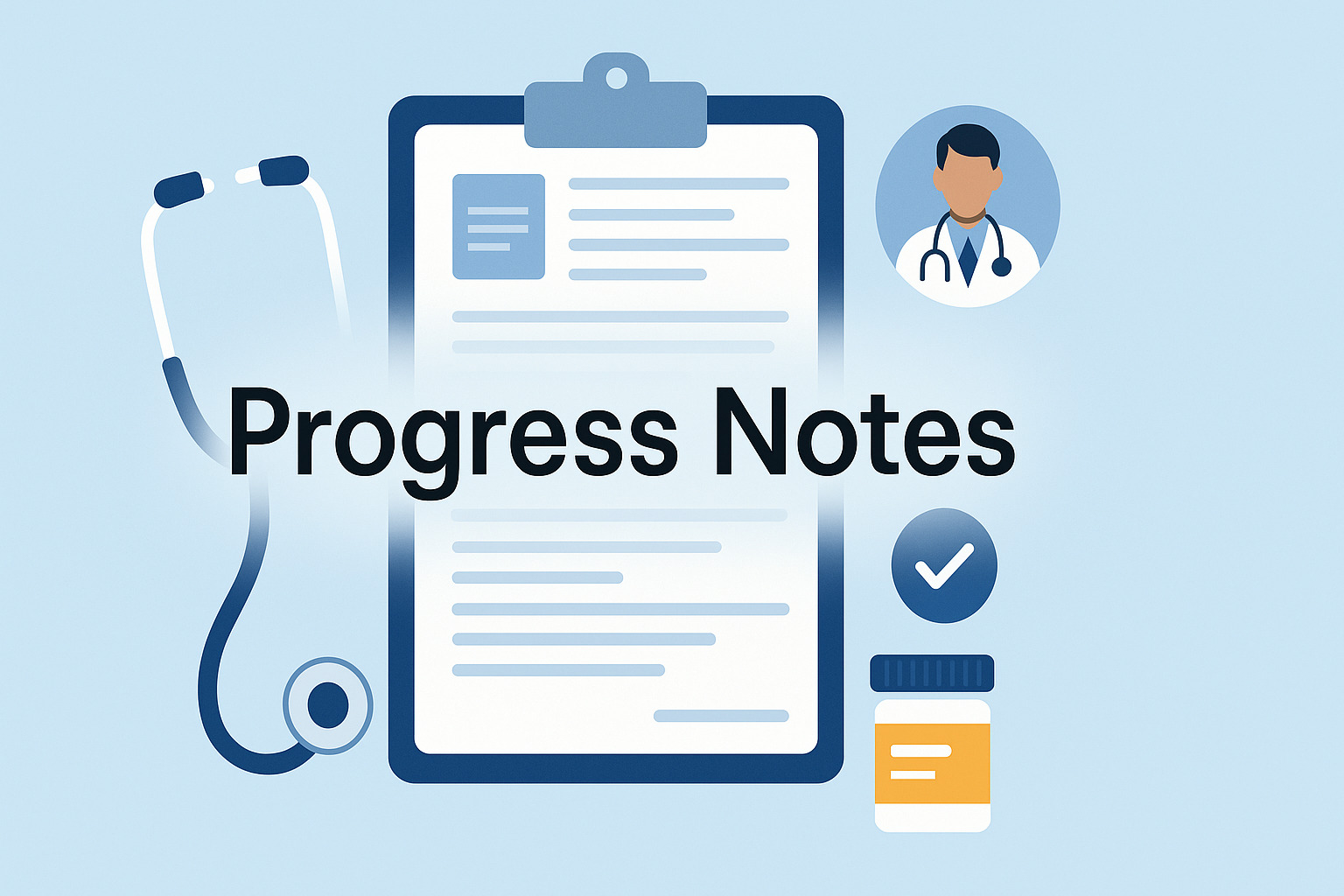Updated on: September 15, 2025
Progress notes are one of the most important forms of clinical documentation. They don’t just record what happened in a visit—they create a living record of patient care. From supporting treatment continuity to ensuring billing compliance, the way you write progress notes directly impacts both patient outcomes and operational efficiency.
But here’s the reality: many clinicians spend hours writing progress notes after their shift, struggling to balance detail, structure, and compliance. That’s why knowing how to write progress notes effectively—and having the right tools—makes all the difference.
With the DocScrib AI Scribe, clinicians can generate structured, ICD-10 aligned progress notes in real time, saving time while improving accuracy.
What Are Progress Notes?
Progress notes are clinical records written by healthcare providers to track patient encounters, treatment updates, and overall care plans. They are:
-
Clinical tools → Guide future care decisions
-
Legal documents → Provide a record of services delivered
-
Billing evidence → Support insurance claims with ICD-10 coding
-
Collaboration aids → Keep multidisciplinary teams aligned
Key Principles: How to Write Progress Notes
1. Be Clear and Concise
Avoid jargon or unnecessary details. Progress notes should be easy to read by any member of the care team.
2. Stay Objective
Record observations and facts, not personal opinions.
3. Use Structured Formats
Templates like SOAP, DAP, BIRP, or GIRP ensure notes are organized and compliant.
👉 Related reading: Types of Progress Notes
4. Document in Real Time
Writing notes immediately after a visit ensures accuracy and reduces errors.
5. Align with ICD-10 Codes
Linking documentation to ICD-10 coding prevents denials and supports billing compliance.
Common Progress Note Formats
SOAP Notes
-
Subjective → Patient’s self-reported symptoms
-
Objective → Clinician’s observations and test results
-
Assessment → Diagnosis and clinical reasoning
-
Plan → Next steps in treatment
DAP Notes
-
Data → Facts and observations
-
Assessment → Clinical interpretation
-
Plan → Recommended interventions
BIRP Notes
-
Behavior → Patient’s behavior or report
-
Intervention → Clinician’s action
-
Response → Patient’s reaction
-
Plan → Next steps
Narrative Notes
Free-form notes that allow clinicians to capture encounters in a storytelling format.
👉 Explore more documentation resources on our Docsib Blog.
How DocScrib Helps You Write Progress Notes Smarter
While knowing how to write progress notes is essential, manual documentation is still time-consuming. The DocScrib AI Scribe enhances the process by:
-
Generating notes in real time during patient encounters
-
Supporting multiple formats (SOAP, DAP, BIRP, GIRP, Narrative, etc.)
-
Automatically suggesting ICD-10 codes
-
Integrating directly with your EHR for one-click storage
-
Ensuring HIPAA & GDPR compliance for all documentation
This means clinicians can write progress notes faster, with greater accuracy, and less after-hours burden.
Benefits of Smarter Progress Note Documentation
For Clinicians
-
Reduced “pajama time” editing
-
Notes written in your style
-
ICD-10 alignment built in
For Hospitals
-
Better compliance and audit readiness
-
Improved billing accuracy
-
Standardized documentation across teams
For Consultants
-
Access to structured, review-ready notes
-
Easier compliance checks
-
Stronger oversight across patient cases
Step-by-Step: How to Write Progress Notes with DocScrib
-
Start Encounter → Begin documentation in your EHR with DocScrib active.
-
Let AI Capture → DocScrib listens and generates structured notes automatically.
-
Review & Edit → Quickly refine and personalize if needed.
-
Apply ICD-10 Codes → AI suggestions help ensure compliance.
-
Save to EHR → One-click transfer makes documentation audit-ready.
FAQs
Q1: Which format should I use for progress notes?
It depends on your specialty. SOAP and DAP are most common, while BIRP and GIRP are widely used in behavioral health.
Q2: Can DocScrib adapt to my documentation style?
Yes—DocScrib personalizes notes over time, matching your writing preferences.
Q3: Are DocScrib progress notes ICD-10 compliant?
Absolutely. ICD-10 coding support is built into every note.
Q4: Is DocScrib HIPAA & GDPR compliant?
Yes—DocScrib meets global security and compliance standards.
Q5: How much time can I save by using DocScrib?
Clinicians report saving 10–15 hours per week on documentation.
Conclusion: Writing Progress Notes Doesn’t Have to Be a Burden
Knowing how to write progress notes is critical for care continuity, compliance, and billing—but it doesn’t have to drain your time. With the DocScrib AI Scribe, clinicians can generate structured, ICD-10 aligned notes instantly, freeing them to focus on patients instead of paperwork.
👉 Ready to transform how you write progress notes? Book a Demo with Docscrib
